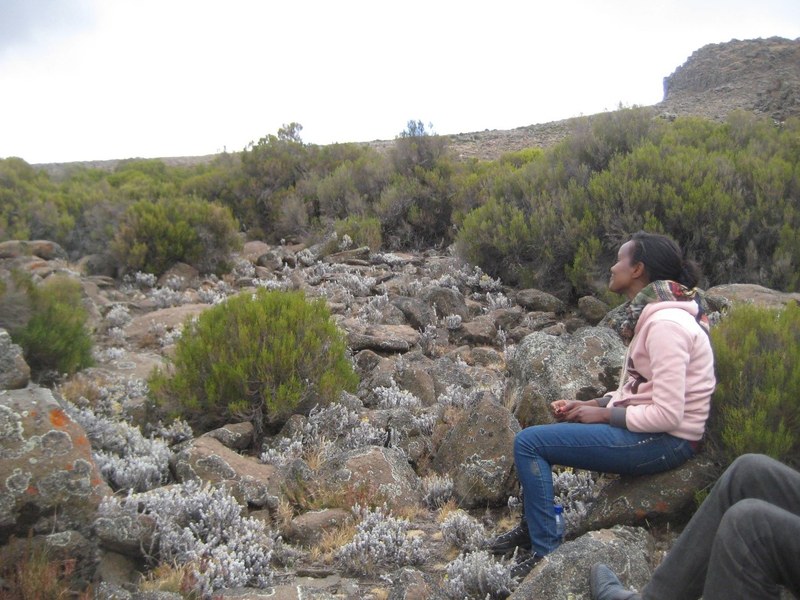Main Content
P2 - Anthrosols and Intensity of Human Occupation
PI: Bruno Glaser, Wolfgang Zech | Tamrat Bekele, Sileshi Nemomissa Duguma, Itanna Fisseha
PhD-Students: Betelhem Mekonnen, Tobias Bromm, Bruk Lemma
Overview
Anthrosols is the typical soil type of the Anthropocene and the human environment (Bork 2006). In the Bale Mountains, Anthrosols are mostly confined below rock cliffs providing shelter against the trade winds. Using numeric dating (14C, OSL), Anthrosols are suitable archives to reconstruct the chronology of human occupation. The Intensity of Human Occupation in space and time will be reconstructed by means of molecular markers with special reference to pyrogenic carbon, using benzenepolycarboxylic acids as a fire tracer (Glaser et al. 1998), stanols and bile acids to detect human and animal excrements, and alkaline CuO oxidation of lignin to differentiate grasses from woody plants and cutin/suberin analysis (Otto and Simpson 2007).
Achievements
- Sanetti Plateau sites without Erica are free of charcoal and have low black carbon contents. Therefore, they are most likely not burnt. Erica occurs preferentially at sites with boulders (Fig. 1).
- Erica vegetation at the Sanetti Plateau could be successfully identified using the phenol pattern (Fig. 2).
- Unambiguous proof of human use of a Middle Stone Age residential site (Fig. 4).
Objectives
- Evaluation of the temperature regime, nutrient and water supply of Erica at the Sanetti Plateau to exclude that mal-nutrition and water stress besides climatic factors (especially temperature) and human impact contribute to the disappearance of Erica on the plateau.
- Identification of unambiguous molecular marker for Erica based on the screening further phenols, tannins, terpenoids and environmental DNA.
- Reconstruction of the temporal and spatial distribution of the Erica vegetation at the Sanetti Plateau based on biogeochemical analyses of soils and sediments in depressions and lakes.
- Investigation of Anthrosols older than 10 ka found under rock shelters in parts of the Sanetti Plateau not studied up to now.
- Spatial up-scaling of human occupation at the Sanetti Plateau.


Figure 1 : Erica vegetation at sites with boulders on the Sanetti Plateau, Ethiopia
Figure 2: Rockshelter site
Publications
Mekonnen, B., Glaser, B., Zech, R. et al. Climate, vegetation and fire history during the past 18,000 years, recorded in high altitude lacustrine sediments on the Sanetti Plateau, Bale Mountains (Ethiopia). Prog Earth Planet Sci 9, 14 (2022).
https://doi.org/10.1186/s40645-022-00472-9
Lemma, B., Bittner, L., Glaser, B., Kebede, S., Nemomissa, S., Zech, W., Zech, M. (2021): δ2Hn-alkane and δ18Osugar biomarker proxies from leaves and topsoils of the Bale Mountains, Ethiopia, and implications for paleoclimate reconstructions. Biogeochemistry.
DOI: 10.1007/s10533-021-00773-z
Lemma, B.; Seifu Kebede, G.; Nemomissa, S.; Otte, I.; Glaser, B. & Zech, M. (2021): Spatial and temporal 2H and 18O isotope variation of contemporary precipitation in the Bale Mountains, Ethiopia. Isotopes in Environmental and Health Studies 56(1), 1-14.
DOI: 10.1080/10256016.2020.1717487
Lemma, B.; Grehl, C.; Zech, M.; Mekonnen, B.; Zech, W.; Nemomissa, S.; Bekele, T. & Glaser, B. (2019): Phenolic Compounds as Unambiguous Chemical Markers for the Identification of Keystone Plant Species in the Bale Mountains, Ethiopia. Plants 8(7), 1-15.
DOI: 10.3390/plants8070228
Lemma, B.; Mekonnen, B.; Glaser, B.; Zech, W.; Nemomissa, S.; Bekele, T.; Bittner, L. & Zech, M. (2019): Chemotaxonomic patterns of vegetation and soils along altitudinal transects of the Bale Mountains, Ethiopia, and implications for paleovegetation reconstructions – Part II: lignin-derived phenols and eaf-wax-derived n-alkanes. E&G Quaternary Science Journal 68, 189-200.
DOI: 10.5194/egqsj-68-189-2019
Gil-Romera G, Adolf C, Benito B, Johansson M, Bittner L, Fekadu M, Glaser B, Mekonnen B, Grady D, Lamb H, Lemma B, Rensen D, Zech M, Zech W, Miehe G (2019) Long-term fire resilience of the Ericaceous Belt, Bale Mountains, Ethiopia. Biology Letters 15.
https://doi.org/10.1098/rsbl.2019.0357
Ossendorf G, Groos AR, Bromm T, Tekelemariam MG, Glaser B, Lesur J, Schmidt J, Akçar N, Bekele T, Beldados A, Demissew S, Kahsay TH, Nash BP, Nauss T, Negash A, Nemomissa S, Veit H, Vogelsang R, Woldu Z, Zech W, Opgenoorth L & Miehe G (2019) Middle Stone Age foragers resided in high elevations of the glaciated Bale Mountains, Ethiopia, Science 365 (2019), 583-587.
DOI: 10.1126/science.aaw8942
Ossendorf, G.; Girma, M.T.; Lesur, J.; Groos, A.R.; Bromm, T.; Glaser, B.; Negash, A.; Beldados, A. & Vogelsang, R. (2019): Late Pleistocene hunter-gatherer occupation of high-altitude afro-alpine ecosystems in the Bale Mountains, South Ethiopia. Presented at INQUA, Dublin, Ireland.
Mekonnen B, Glaser B, Zech M, Addis A, Nemomissa S, Bekele T, Zech W (2018) Late Glacial and Holocene landscape history of the Sanetti Plateau, Bale Mountains (Ethiopia) as deduced from biogeochemical proxies of lacustrine sediments. Poster presented at the conference of the German Association of Stable Isotope Research, Munich.
Bittner, L.; Lemma, B.; Mekonnen, B.; Glaser, B.; Zech, M. & Zech, W.: First biomarker and stable isotope results from afro-alpine Lake Garba Guracha, Bale Mountains, Ethiopia - potential for paleovegetation and paleoclimate reconstructions. Geophysical Research Abstracts 20, 1-1.
Abstract here
Bittner, L.; Glaser, B.; Lemma, B.; Zech, M.; Zech, W. & Mekonnen, B.: Poster: First biomarker and stable isotope results from afro-alpine Lake Garba Guracha, Bale Mountains, Ethiopia - potential for paleovegetation and paleoclimate reconstructions. Presented at Bale, international.
Mekonnen, B.; Glaser, B.; Zech, M.; Nemomissa, S. (2018); Addis, A.; Bekele, T. & Zech, W.: Late Glacial and Holocene landscape evolution of the Sanetti Plateau, Bale Mountains (Ethiopia), as deduced from biogeochemical properties of lacustrine sediments. Presented at IPA-IAL Joint Meeting, Stockholm,Sweden.
Zech, M.; Tuthorn, M.; Hepp, J.; Zech, R.; Rozanski, K. & Glaser, B. : Compound-specific oxygen isotope (δ18O) analysis of sugar biomarkers in lacustrine sediments – rationale, first applications and perspectives for future research (2018). Presented at IPA-IAL Joint Meeting, Stockholm,Sweden
Glaser, B.(2016): Ice age in Ethiopia: refuge in the mountains?, Issue. Tom Leonhardt .
Master Thesis
Sämann, R. (2020 ) Soil classification and fertility of Erica trimera sites in the upper Bale Mountains, Ethiopia.







